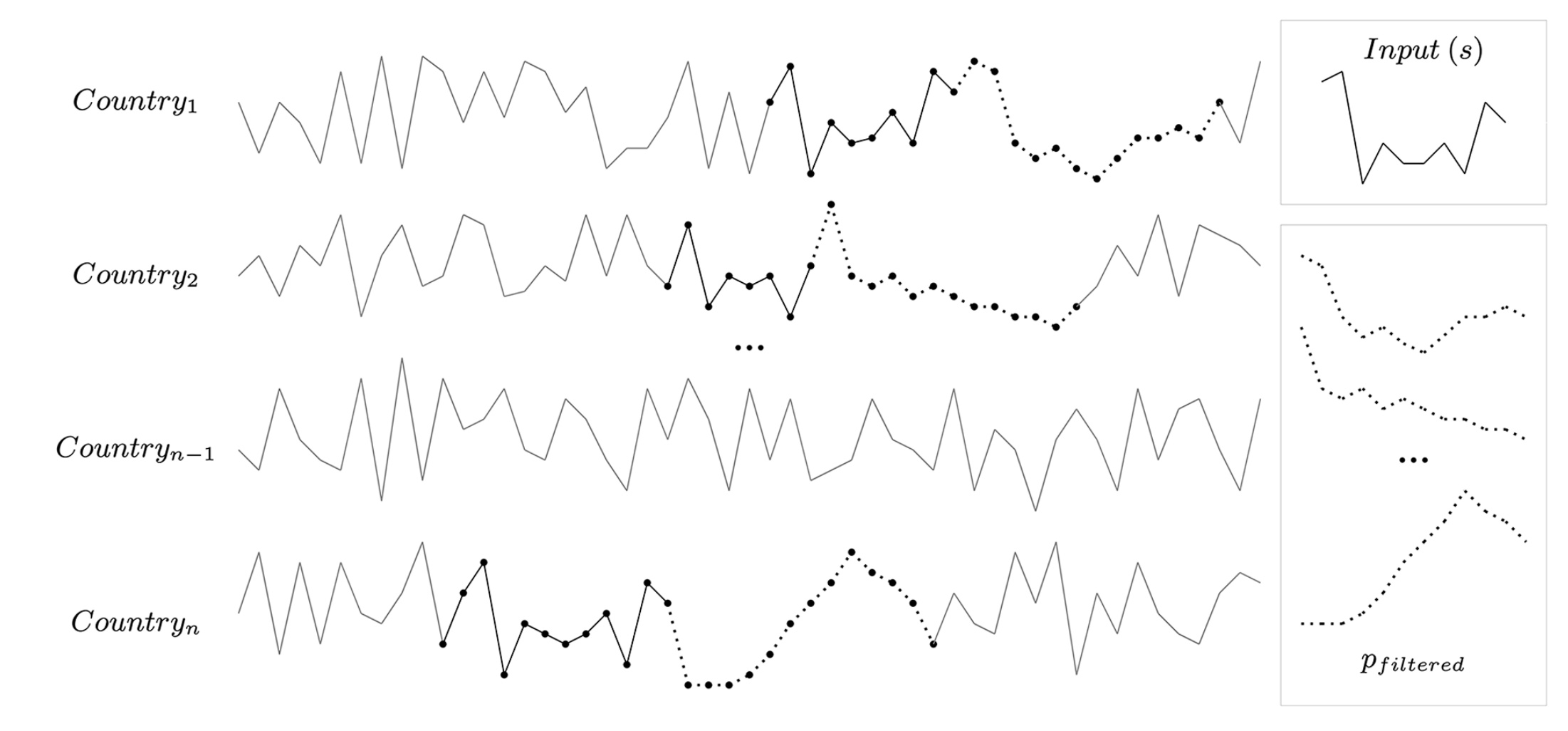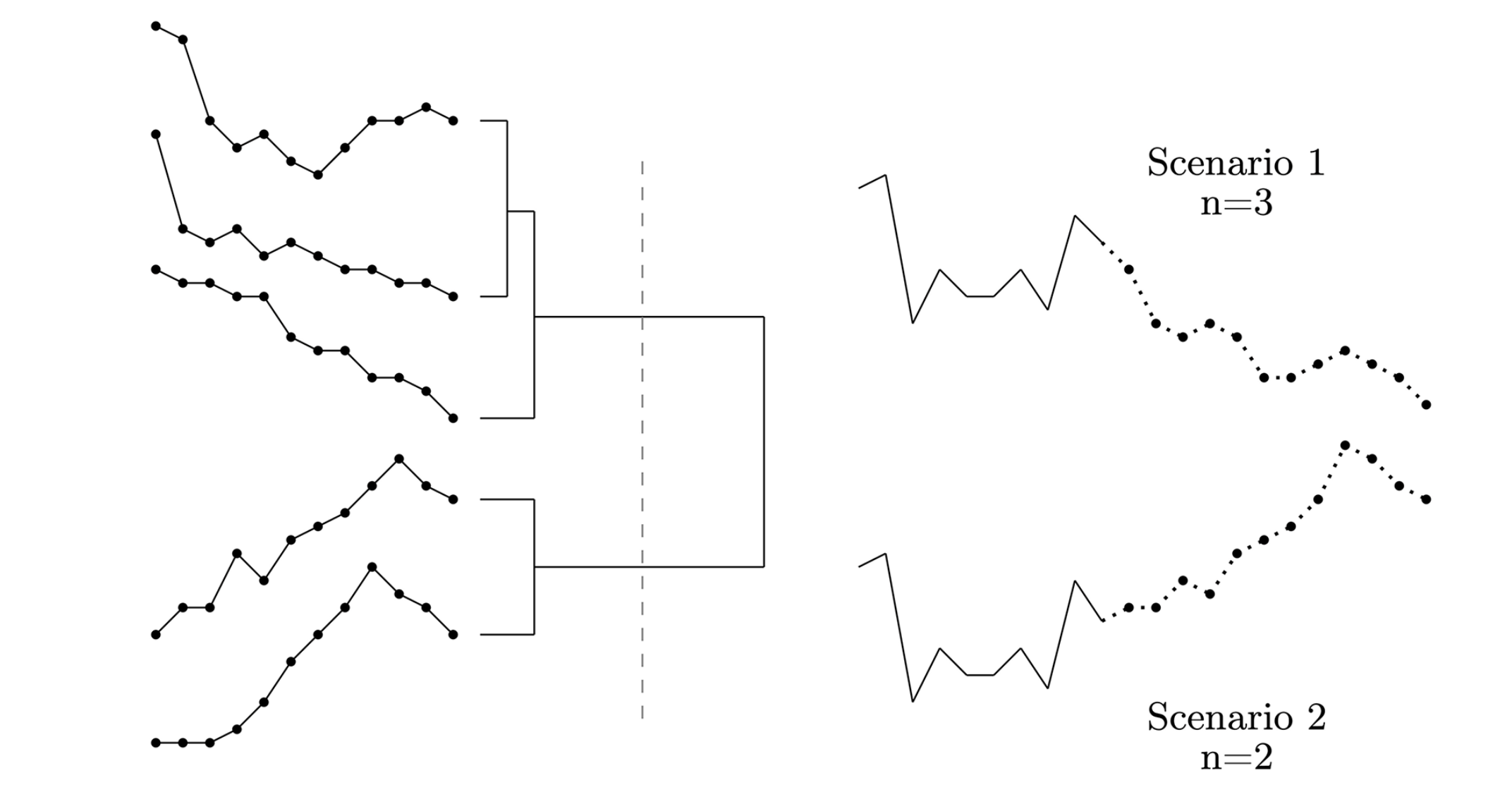Methodology
Machine learning models that forecast geopolitical conflict, civil unrest and migration. Built for precision, transparency, and integration with existing systems.
How Our Forecasting System Works
Data Collection
UCDP conflict events, 1989–present, aggregated to countries & 0.5° grid cells
Feature Engineering
Extract covariates: demographics, climate, economy, governance, spatial lags
Pattern Matching
DTW finds similar historical trajectories
Forecast Generation
Cluster futures and compute centroid for 1–6 month predictions
Validation
Out-of-sample testing and real-world performance monitoring
Key Advantages
- ✓ Interpretable: Can cite specific historical analogues
- ✓ Fast: Minutes, not hours
- ✓ No covariates needed: Only past fatalities required
- ✓ Captures variability: Predicts surges and declines
- ✓ Always available: No lag for data updates
- ✓ Flexible: Handles varying speeds via DTW
Conflict Diffusion Modeling
Our machine learning models predict how conflict spreads across space and time using PRIO-GRID cellular analysis at 0.5° resolution.
Pattern Discovery & Time‑Series AI
We mine sequences for structure — motifs, anomalies, regime shifts — and learn compact embeddings that capture the shape and momentum of real‑world dynamics. Clustering similar trajectories and aligning asynchronous signals lets us surface recurring signatures, spot emerging look‑alikes, and rank what matters most — fast.
The Shape Finder Algorithm
Our forecasting approach finds historical patterns similar to the current trajectory and uses their outcomes to predict the future. This method is purely autoregressive — it uses only past fatalities, no covariates needed.


Spatial-Temporal Pattern Recognition
Each trajectory in this 3D space represents a conflict evolving over time and across geographic coordinates. By analyzing these patterns, we can identify when current conflicts follow trajectories similar to historical ones, allowing us to forecast likely outcomes based on how similar past patterns unfolded.

Conflict trajectories visualized across latitude, longitude, and time dimensions. Similar shapes in this space indicate conflicts with comparable spatial-temporal dynamics, regardless of when or where they occurred.
Data Sources & Processing
Our forecasts are built on high-quality, georeferenced conflict data with careful preprocessing to handle the unique challenges of violence data.
Primary Data Source
Uppsala Conflict Data Program (UCDP)
- • 1989–2025 (36 years)
- • Global coverage
- • Georeferenced incidents
- • Daily/monthly aggregation
- • Updated monthly
Aggregation Levels
Country-level: National aggregates
Grid-level: PRIO-GRID cells at 0.5° resolution (~55 km × 55 km at the equator)
The grid-level approach captures sub-national heterogeneity and spatial diffusion patterns that country-level data misses.
What We Feed The Models
Beyond past violence, our models ingest diverse signals on population, economy, politics, climate, access, and contagion. Below are examples of the kinds of covariates we use (non‑exhaustive).
Conflict history & contagion
Lagged local fatalities; spatial lags from neighboring cells; distance to most recent events.
Demography & exposure
Population density; urban–rural share; distance to capital or major city; settlement proximity.
Economy & prices
Night‑time lights; food & commodity prices; inflation; GDP per capita; local market activity.
Governance & politics
Election calendar; regime type & constraints; emergency measures; protest restrictions.
Climate & environment
Rainfall anomalies; temperature anomalies; drought indices (e.g., SPEI); vegetation (NDVI).
Infrastructure & access
Road network & travel time; border proximity; remoteness; mobile & internet coverage.
Displacement & flows
Refugee/IDP stocks & flows; cross‑border mobility; reception capacity and pressures.
Security & armed actors
Presence of organized groups; known corridors & operating areas; arms trafficking routes.
Market & livelihoods
Local food prices; crop/harvest proxies; shocks to household purchasing power.
Performance & Validation
Our models undergo rigorous out-of-sample testing and real-world validation against leading forecasting systems.
Key Findings
Pattern Repetition
Conflict sequences repeat significantly more than random processes (earthquakes, stock markets, white noise)
Cross-Context Generalization
Patterns generalize across regions and decades — similar dynamics emerge in different places and times
Predictive Power
Similar patterns predict similar futures — historical analogues provide actionable forecasts
Temporal Information Dominates
Autoregressive models (AR) ≈ AR + Covariates >> Covariates alone — past patterns matter more than structural variables
Where Our Approach Excels
- ✓ High-intensity conflicts with complex dynamics
- ✓ Situations with substantial trajectory variability
- ✓ Short to medium-term horizons (1-6 months)
- ✓ Capturing escalation and de-escalation patterns
- ✓ Identifying turning points and regime shifts
- ✓ Providing interpretable historical analogues
Limitations & Forecast Ceiling
No forecasting system is perfect. Research across multiple projects suggests an 80-85% accuracy ceiling for conflict forecasting due to:
- • Data measurement error and reporting bias
- • Quasi-random structural error (complex systems)
- • Rational randomness (strategic unpredictability)
- • Arational randomness (free will, idiosyncratic factors)
- • Effective policy response (successful prevention)
- • Unpredictable exogenous shocks
See: Schrodt (2018) on irreducible sources of error
Validation results from: Hegre et al. (2024) |Schincariol, Frank & Chadefaux (2025)
Applications Beyond Conflict
Our pattern recognition methods extend to other domains with temporal dynamics.
Protest Dynamics
Pattern-based forecasting of protest escalation and transitions to violence. Patterns generalize across contexts.
Schincariol & Chadefaux (2025)
Migration Flows
Time-series forecasting of displacement and refugee movements using historical pattern matching.
Schincariol & Chadefaux (2024)
Humanitarian Early Warning
Anticipate humanitarian needs based on predicted conflict trajectories and displacement patterns.
Diplomatic Planning
Identify windows of opportunity for intervention based on pattern-informed forecasts of escalation.
Resource Allocation
Deploy peacekeeping forces, humanitarian resources, and preventive diplomacy where and when most needed.
Risk Assessment
Provide business, NGO, and government stakeholders with actionable forecasts for operational planning.
Live Global Risk Intelligence
Real-time conflict forecasts powered by our machine learning models